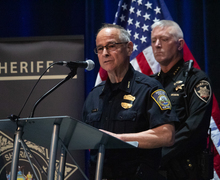Photographer to speak about effects of light pollution on night sky
A photograph is more than just a thousand words. It tells a story of the past and the present, of things to cherish and those in danger of fading forever — like a black night sky.
National Geographic photographer Jim Richardson will speak about “Our Vanishing Night: Light Pollution” on Tuesday at 7:30 p.m. in Hendricks Chapel.
The talk, which is a part of the University Lectures series, is free and open to the public.
Richardson has photographed more than 25 stories for National Geographic. His assignments have taken him around the world, from the frozen waters of Antarctica to Scotland’s rugged green hills. He is also a contributing editor at National Geographic Traveler, National Geographic’s sister publication.
His photography contains everything from everyday norms to breathtaking, exotic subjects, said Esther Gray, coordinator of the University Lectures series.
“His photography captures things in photos that most of us never see, even if it is right in front of us,” she said in an email. “He was a perfect fit for University Lectures.”
Coordinators for University Lectures chose to add Richardson to this year’s lineup because of his expertise in light pollution. Gray said she has not seen any other speakers cover the topic. She hopes students will learn from the story Richardson tells through his photography, as well as his environmental message.
“I think we all deserve an evening to sit and enjoy, but also to learn,” she said.
Most people don’t usually think about light pollution, said Thomas Perrault, an associate geography professor in the Maxwell School of Citizenship and Public Affairs. People, specifically those in urban areas, live with constant light due to modern technology, such as streetlamps and house lights.
It is a growing issue, Perrault said. As a geographer, he finds the contrast between light pollution in heavily urbanized areas and in undeveloped spaces interesting. He said he looks forward to the aesthetic aspects of Richardson’s presentation, particularly his photographs.
Elet Callahan, the faculty director of the sustainable enterprise partnership, said she thinks Richardson’s speech will provide an exciting opportunity for members of the Syracuse University community.
Because Richardson is one of National Geographic’s top photographers, Callahan said she thinks his experience can teach students a lot.
“I hope students will learn about light pollution as an issue and its significance in terms of something that’s not pretty, but also in terms of the significance of its impact on humans and the ecosystem,” she said.
To have such a well-known photographer come to campus is exciting, said Kirsten Celo, a senior photojournalism major.
“He’s particularly interesting because he has a wide variety of photography,” said Celo, also a staff photographer for The Daily Orange. “He does everything, and he does it really well.”
Richardson is scheduled to speak the same night as Susan Meiselas, another internationally known photographer. Because of the time conflict, Celo is still deciding which lecture to attend. She finds it unfortunate that she, as well as other members of the multimedia photography and design department, must chose between the two.
Said Celo: “We get people to come talk to us, but it’s not an everyday thing.”
Published on March 18, 2013 at 11:46 pm
Contact Kerry: [email protected]




